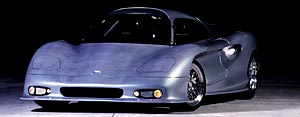
VOLUME 1, NUMBER 1 | SPRING 1998
 |

By Steve Gottschalk
In a highly competitive global economy, the right hardware, software, enabling technology and services promise vastly enhanced productivity on every engineer's desktop throughout the enterprise for manufacturers and suppliers everywhere. Virtual product development is the cornerstone of an important revolution in automotive design that promises to accelerate the design process while lowering overall costs.
Advances in mechanical computer-aided design (MCAD), including high-speed, 3D visualization and digital-prototyping tools, free designers to design better, more reliable products faster and cheaper using "virtual" rather than "real" or physical models. The story of Romulus Predator, an American-made high-performance "supercar," is an excellent case in point. Unveiled at AutoFact in November 1997, this car was the result of an intensive collaborative design effort between designer Mark Gerisch, Hewlett-Packard Company and four industry-leading mechanical-design-software vendors.
Gerisch, president and chief executive officer of M&L; Auto Specialists, Inc., of Two Rivers, Wis., is a 17-year veteran in building quality auto reproductions. In his business, Gerisch works with designers from the top three U.S. auto makers, and it was through them that he first learned about HP's innovative work in the automotive industry. At the time he came to HP for help, he was using clay and steel models and had limited drafting automation. When Gerisch met with HP, he stressed that time was running out on his project; he needed to complete the Supercar by the AutoFact Show in Detroit.
HP drew on its experience working with MDA automotive designers and top independent industry software vendors to coach Gerisch into implementing a virtual prototyping model. Gerisch drew up a list of leading solution providers in each category of the MCAD process and decided to enlist the help of EDS Unigraphics, Engineering Animation, Inc., ICEM Technologies and The MacNeal-Schwendler Corp. Three and one-half months later, Gerisch introduced the Romulus Predator supercar at the AutoFact show -- on time and under budget. The success of this project was the result of an innovative team spirit and a truly collaborative engineering approach. HP provided the UNIX and Windows NT platforms (HP VISUALIZE Model B- and C-class workstations and HP Kayak XW Personal Workstations), advanced graphics hardware systems (HP VISUALIZE fx graphics) and interoperability tools to enable virtual product design. EDS Unigraphics contributed computer-aided design modeling software to enable a fast-track implementation of the virtual development environment. Initial designs were released to a shared database as a digital assembly of solid representations of individual chassis and components.
Engineering Animation, Inc. (EAI) provided VisFly and VisMockUp, visual-communications and digital-prototyping software, which enabled geographically dispersed design teams and suppliers to interact with, view and analyze the digital model in real-time so design flaws could be identified and fixed.
ICEM Technologies furnished ICEM Surf, surface-modeling software which obtained mathematical data from the digital model car to create realistic, sophisticated surfaces while eliminating the need to build and evaluate a surface out of metal or fiberglass. The MacNeal-Schwendler Corp. provided MSC/PATRAN and MSC/NBASTRAN, an open architecture finite element modeling and analysis system, which analyzed and optimized the vehicle structure, helping remove weight from the vehicle while maintaining strength.
Using the tools provided by HP and its partners, Gerisch was able to pull together the Predator project in approximately three months. Without these tools, the process would have required six months or more in the physical prototyping stage alone (a typical automotive design requires two to three physical mock-ups). HP also served as a consultant to help Gerisch develop the appropriate IT infrastructure for the project.
Virtual Product Development Now
Virtual prototyping is the realistic computer simulation of a product and addresses every stage of the product-design continuum, from concept and design to analysis and manufacturability.
| Realistic, high-speed, 3D visualization and digital-prototyping tools from HP and its partners have emerged as powerful engineering solutions, helping users meet the challenge of designing better, more reliable products for less cost and in shorter timeframes. These tools provide powerful interactive performance for the viewing of complex virtual models of real polygonal data and simulations, allowing manufacturers to reduce or bypass multiple physical prototype stages and achieve a significantly higher level of efficiency in automotive product design by cutting months and cost from the development cycle. |
 VIRTUAL PRODUCT
|
Utilizing virtual product development to reduce design cycles and the number of physical prototypes required helps cut manufacturing costs and saves time. It also can help foster higher product quality. In automotive design, sophisticated computer systems can now automatically output displacements, velocities, accelerations and reaction forces, displaying the results as realistic 3D animations to ease visualization and foster more effective communication of concepts. This data is used to evaluate overall mechanical system performance, range of motion, collision detection and peak loads, as well as to calculate finite element analysis load inputs. This process facilitates more rigorous and thorough functional pre-production tests leading to a higher quality product with fewer warranty costs over its lifetime.
And in the Future
Given the many benefits cited here, it seems apparent that virtual product development holds great promise for not only the automotive but for other industries as well. Its inherent economy holds an exciting promise for smaller companies, like M&L; Auto, who are looking to bring tomorrow's visions to reality today.
Steve Gottschalk is the mechanical design automation (MDA) program manager for Hewlett-Packard's Workstation Systems.
Web Site © Copyright 2020 by Lionheart Publishing, Inc.
All rights reserved.
Lionheart Publishing, Inc.
2555 Cumberland Parkway, Suite 299, Atlanta, GA 30339 USA
Phone: +44 23 8110 3411 |
E-mail:
Web: www.lionheartpub.com
Web Design by Premier Web Designs
E-mail: [email protected]